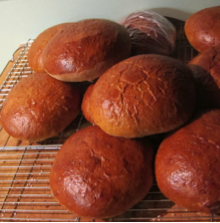Swedish Finn Culture
Uleåborgslimpa or Oulunlimppu
By Syrene Forsman

1 package active dry yeast
¼ cup warm water
½ cup light molasses
1 tbs grated orange peel *
1 ½ teaspoons salt
2 tsps caraway or fennel seed **
2 cups buttermilk
3 cups rye flour
3-3 ½ cups white flour ***
Dissolve the yeast in the ¼ cup warm water (¼ tsp sugar helps the proof); set aside. Mix the molasses, orange peel, salt, and caraway seed in a saucepan and bring to a boil. Pour into a large mixing bowl and add the buttermilk. Cool to lukewarm. Add the yeast and blend well. Add the rye flour gradually and beat well. Add the white flour, beating well after each addition. When the mixture is stiff, let it rest for 15 minutes before kneading.
Turn the dough out onto a floured board and knead until satiny smooth, then place in a lightly greased mixing bowl, turning to grease the top, cover with Saran wrap and let rise in a warm place until double in bulk (about 1 hour). Turn out again onto a floured board and divide into 2 parts. Shape each half into a round fat ball or into a rectangular loaf about 4 by 8 inches. Place (covered with Saran wrap) on a greased baking sheet and let rise until almost doubled (about 30 minutes).
Before baking, brush the loaves with beaten egg. Bake in a moderate oven (350 degrees) for 45-50 minutes (Maybe less. Watch carefully). Makes two large loaves. The basic recipe is from Beatrice Ojakangas’ book, The Finnish Cookbook, with adjustments to make it taste like my mother’s bread.
Notes:
* I use a tablespoon+ of cheap orange marmalade
** I use 2 tablespoons!
*** Add 1 tablespoon gluten here as well
Written by John Forsberg, March 1994. Translated by June Pelo. According to expert interpretation of the indistinct text in the Malax communion book of 1667, Jåpa(r)s farm (Jåp=Jakob), is what…
Written by Hugo Theodor Nilsson Sandkulla. Submitted to June Pelo by Hugo’s granddaughter, Kristin Nelson. The time came now, for American fever set into my way of thinking and I…
Extracted from an article by Heikki Ylikangas from “Exploring Östrobothnia”. Translated by June Pelo. Historically Östrobothnia extends from just north of the city of Pori deep into the far north…
By Ole Granholm, Österbottningen newspaper, 8 May 2003. Translated by June Pelo. When Ford started production of his Model T, the three brothers Alexander, Fritjof and Tor Nyberg from Nedervetil…
Following are recollections of two settlements in Malax by former residents of long ago. Bränno By M. Edv. Bonns from “Den Österbottniska Byn”. Translated by June Pelo. Bränno was part…
Pia Norrgård, Österbottningen, Norden 2 Sep 2004. Translated by June Pelo. For over 60 years Kia Schley’s father Karl-Erik Inberg searched for relatives in the United States. When he died Jorma…
By Ole Granholm, Österbottningen 31 July 1965. English translation by June Pelo. Oil king John D. Rockefeller employed over 20 servants in his home in the country and among those…
Excerpted from “Separation and Self-Sufficiency” by Janet Rasmussen. Translated by June Pelo. This is a story of immigrants from Scandinavia. An immigrant from Nås, Sweden to the United States in…
By June Pelo. No source cited. Prior to about 1850 all Scandinavian countries used a form of patronymics. The given name of a father was used as a surname for…
By Edvin Brännbacka. Sources: E. Karsten: Swensk Bygd i Österbotten, Nu och Fordom, I & II E. Ohls: Bynamnen i 1500-talets Karleby och Pedersöre socknar V. Åkerblom: Pedersöre Storsockens Historia…